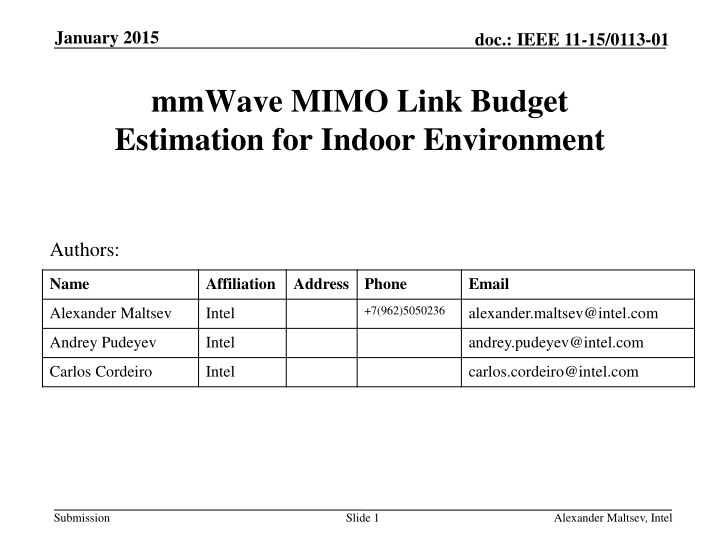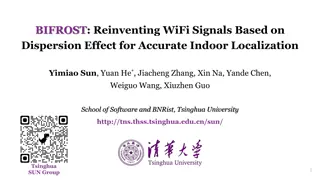Estimation for Indoor Environment
This document discusses the implementation of mmWave MIMO technology for NG60, exploring spatial separation options, hybrid RF-BB beamforming, system analysis assumptions, and simulation results. It covers aspects like antenna arrays, channel frequency selectivity, spatial stream separation, beamforming techniques, and system configurations.
Download Presentation

Please find below an Image/Link to download the presentation.
The content on the website is provided AS IS for your information and personal use only. It may not be sold, licensed, or shared on other websites without obtaining consent from the author.If you encounter any issues during the download, it is possible that the publisher has removed the file from their server.
You are allowed to download the files provided on this website for personal or commercial use, subject to the condition that they are used lawfully. All files are the property of their respective owners.
The content on the website is provided AS IS for your information and personal use only. It may not be sold, licensed, or shared on other websites without obtaining consent from the author.
E N D
Presentation Transcript
January 2015 doc.: IEEE 11-15/0113-01 mmWave MIMO Link Budget Estimation for Indoor Environment Authors: Name Affiliation Address Phone Email +7(962)5050236 Alexander Maltsev Intel alexander.maltsev@intel.com Andrey Pudeyev Intel andrey.pudeyev@intel.com Carlos Cordeiro Intel carlos.cordeiro@intel.com Submission Slide 1 Alexander Maltsev, Intel
January 2015 doc.: IEEE 11-15/0113-01 Agenda mmWave MIMO for NG60 MIMO mode: spatial separation options MIMO implementation: Hybrid RF-BB beamforming mmWave MIMO system analysis assumptions Simulation results and discussion Omnidirectional antennas 2x8 phased antenna arrays Conclusion Submission Slide 2 Alexander Maltsev, Intel
January 2015 doc.: IEEE 11-15/0113-01 mmWave MIMO for NG60 2x2 SU-MIMO as baseline Currently no applications/requirements for x4 higher throughputs Cost/complexity/efficiency limitations Implementation Hybrid beamforming in RF and BB is a practical solution High-throughput (>2 data streams) and high reliability (1 stream) modes are possible Channel frequency selectivity issues OFDM-MIMO for frequency selective channel vs. SC-MIMO for flat channel Spatial streams separation options - next slide Submission Slide 3 Alexander Maltsev, Intel
January 2015 doc.: IEEE 11-15/0113-01 MIMO spatial stream separation options Omni antennas with BB processing Theoretical investigations for large number of antennas [1]. Max gain for 2x2 can be achieved only at optimal positions. Spatial separation: LOS MIMO with directional arrays Operation range defined by antenna arrays spacing and beamwidth [2]. Spatial separation: Reflection-based MIMO with directional arrays Data transmit over reflected rays require high additional antenna directivity. Polarization separation Dual-polarization arrays [3]. Two separate arrays with orthogonal polarization [2]. Different combinations of all approaches above RX Array 1 Maximal gain into the corresponding antenna direction Ilumination spot is Less than destance between RX arrays RX Array 2 TX Array 1 TX Array 2 RX Array 1 V-polarized signal RX Array 2 H-polarized signal TX Array 1 TX Array 2 [1] Indoor Millimeter Wave MIMO: Feasibility and Performance , E. Torkildson, U. Madhow, M. Rodwell, IEEE Transactions on Wireless Communications, vol. 10, no. 12, December 2011 [2] Next Generation 802.11ad: 30+ Gbps WLAN , C. Carlos et al., Doc. IEEE 11-14/0606r0, 2014 [3] MIMO option for NG60 , Amichai Sanderovich, Qualcomm, Doc.IEEE 11-15/0069r0, 2015 reflector Link 2 Beam-forming 2x8 antenna array Null-forming 2Tx 2Rx Link 1 Submission Slide 4 Alexander Maltsev, Intel
January 2015 doc.: IEEE 11-15/0113-01 Hybrid RF and BB beamforming It is possible to create a MIMO system by combining multiple RF signals in one BB through a hybrid beamforming scheme. Two approaches are possible: Relatively simple modification of IEEE802.11ad to support multi-stream transmission on the base of several arrays New antenna + RF design with maximal antenna aperture for both streams Phi 11 Phi 12 RF1 Alpha 1 Phi 1N BB Phi 21 Phi 22 Alpha 2 RF2 Phi 2N Submission Slide 5 Alexander Maltsev, Intel
January 2015 doc.: IEEE 11-15/0113-01 Hybrid beamforming: two stages RF and BB Signal #2 Signal #1 Hybrid beamforming consists of two stages: Coarse (RF) and Fine (BB) beamforming Coarse beamforming: sector sweep in RF to establish one or several independent links (rays) between TX and RX antennas Fine beamforming: optimal weighting done in BB in accordance with given criterion Set of channels after coarse beamforming between different TX-RX beams may be treated as a virtual MIMO channel, and well-known MIMO techniques can be applied to those channels Antenna elements Antenna array #2 Antenna array #1 Phase shifters RF signal Summators (RX) or Multiplexors (TX) RF To BB RF To BB Radio frequency to Baseband transformation Channel estimation and weights calculation Interference cancellation block Submission Slide 6 Alexander Maltsev, Intel
January 2015 doc.: IEEE 11-15/0113-01 mmWave MIMO system link budget analysis: system assumptions MIMO beamforming modes RF beamforming: Ideal orientation of beams along the pre-selected rays (scenario dependent) BB beamforming: 2 x 2 MIMO (with omni or phased antenna arrays) OFDM-MIMO system Ideal channel estimation Ideal SVD-MIMO processing Per-subcarrier beamforming Output metrics Theoretical capacity Throughput MCS selection based on the OFDM MMIB PHY abstraction results from IEEE 802.11ad LLS OFDM data rates from 0.7 Gbps (SQPSK 1/2) to 6.7 Gbps (64 QAM 13/16) Deployment scenario Indoor environment Simplified office deployment: table and walls Wireless docking station usage model Submission Slide 7 Alexander Maltsev, Intel
January 2015 doc.: IEEE 11-15/0113-01 Wireless docking station scenario Deployment geometry TX at the docking station Htx = 15 cm (tower docking station ) Ptx = 10 dBm total (for all antennas) Dtx = 10 cm (distance between TX antennas) RX at the laptop (with open lid) Hrx = 15 cm (upper edge of screen) Pthermal= -81.5 dBm(BW = 1760 MHz), NF = 15 dB Drx = 20 cm (distance between RX antennas) Propagation: two cases Free space (LOS, no reflections) Simplified office deployment: table and walls as a reflection surfaces Antennas Omni-directional 2x8 phased antenna arrays Antenna patterns based on real design Array gain 15 dBi (HPBWs: [15 , 60 ]), beams are narrow in horizontal plane Polarization either vertical for both antennas, or orthogonal for polarization stream separation case Omni antennas: cross-polarization leakage set to 15 dB 2x8 arrays: cross-polarization leakage depends on radiation angles (20-30 dB) Drx Dtx 2x2 of 2x8 arrays, Free space 2x2 Omni, Free space 2x2 of 2x8 arrays, table reflection Submission Slide 8 Alexander Maltsev, Intel
January 2015 doc.: IEEE 11-15/0113-01 Theoretical illustration: Free space, co-polarized vs. ideally cross-polarized omni antennas For ideally cross-polarized antennas, 1st and 2nd SVD subchannels (blue and green dashed lines) are the same and total capacity (red dashed line) is exactly doubled SISO mode. For co-polarized antennas 1st SVD subchannel (blue line) is always better than 2nd (green), and the total capacity suffers fading effect due to phase shifts between TX1-RX1 and TX1-RX2 channels, but in average it is larger than capacity for ideally cross-polarized antennas Total capacity for 2x2 cross-polarized antennas Two separate cross-polarized channels Submission Slide 9 Alexander Maltsev, Intel
January 2015 doc.: IEEE 11-15/0113-01 2x2 MIMO with omni antennas (XPD:15 dB), Free space For free space MIMO capacity variations occur due to phase shifts between TX1-RX1 and TX1- RX2 channels 2x2 cross-polarized antennas system has smaller range than 2x2 co-polarized system since the power divided equally between identical independent spatial subchannels. 2x2 cross-polarized antennas 2x2 co-polarized antennas Submission Slide 10 Alexander Maltsev, Intel
January 2015 doc.: IEEE 11-15/0113-01 2x2 MIMO with omni antennas (XPD:15 dB), Table reflection For table reflection MIMO capacity for both co-polarized and cross polarized antennas suffers deep fading due to direct and reflected rays interference. The minimum guaranteed throughput for 2x2 MIMO is not significantly larger that for SISO mode Submission Slide 11 Alexander Maltsev, Intel
January 2015 doc.: IEEE 11-15/0113-01 mmWave MIMO with omni antennas: summary MIMO mode Effective range Environment Throughput Notes Free space 2.5 m 1-7 Gbps No fading effects, range limited by TX power SISO Deep fading effect due to reflection decreases the performance Phase fading effects for range less than 1.5 m. More power into the 1st spatial subchannel increases range up to 3.5m. Deep fading effect due to reflection decreases the performance Spatial streams are independent due to polarization separation, range is less than for co-polarized case Deep fading effect due to reflection decreases the performance Table 1.2m 1-7 Gbps 2x2 MIMO Co- polarized antennas Free space 4.5 m 1-10 Gbps Table 1.5 m 1-10 Gbps 2x2 MIMO Cross- polarized antennas Free space 3.5 m 1-10 Gbps Table 1.5 m 1-10 Gbps The mmWave MIMO on the base of omni-directional arrays provides very limited range in this case. The overall MIMO gain is not significant, since the table reflected rays interference causes deep gaps. The 2x2 co-polarized antennas setup shows slightly better performance than 2x2 cross-polarized antennas. Submission Slide 12 Alexander Maltsev, Intel
January 2015 doc.: IEEE 11-15/0113-01 2x2 MIMO with 2x8 phased antenna arrays, Free space For free space, the 2x2 co-polarized antennas capacity decreases due to neighbor antenna arrays 1st spatial subchannel grating lobes interference. For cross-polarized antennas this effect is not observed. Submission Slide 13 Alexander Maltsev, Intel
January 2015 doc.: IEEE 11-15/0113-01 2x2 MIMO with 2x8 phased antenna arrays, Table reflection For table reflection MIMO capacity for both co-polarized and cross polarized antennas suffers deep fading due to direct and reflected rays interference. For 2x2 co-polarized antenna case, an additional fading is observed due to influence of the beamforming grating lobes. Submission Slide 14 Alexander Maltsev, Intel
January 2015 doc.: IEEE 11-15/0113-01 mmWave 2x2 MIMO with 2x8 antenna arrays: summary MIMO mode Effective range Environment Throughput Notes High gain of TX and RX antennas allows operation within whole range of interest Direct and reflected rays interference may cause deep fading gaps at certain distances Sidelobes interference may cause some performance degradation for co-polarized case Direct and reflected rays interference may cause deep fading gaps at certain distances Cross-polarized antennas provide two clear subchannels and double rate within whole range Direct and reflected rays interference may cause deep fading gaps at certain distances Free space 10 m 7 Gbps SISO Table 10 m 2-7 Gbps 2x2 MIMO Co- polarized antennas 2x2 MIMO Cross- polarized antennas Free space 10 m 9-14 Gbps Table 10 m 5-14 Gbps Free space 10 m 14 Gbps Table 10 m 3-14 Gbps Submission Slide 15 Alexander Maltsev, Intel
January 2015 doc.: IEEE 11-15/0113-01 SISO vs. MIMO comparison, big picture For between the SISO and MIMO we need not only set up equal TX power, but also the identical antenna configurations The SISO system on the base of two 2x8 arrays (2x16 elements array) shows the same performance as 2x2 MIMO at large distances (SVD produces [1; 1] beamforming vectors for TX and RX) On the distances less than 30-40m the MIMO processing gives more capacity than SISO with the same antenna system configuration. apple-to-apple comparison Submission Slide 16 Alexander Maltsev, Intel
January 2015 doc.: IEEE 11-15/0113-01 Conclusion The OFDM-MIMO system with hybrid beamforming analyzed for wireless docking station scenario for omni and directional, co-polarized and cross- polarized antennas in free space and typical office environments. The implementation of the 2x2 MIMO on the base of omni antennas is problematic due signal weakness and fading effects. For free space, the 2x2 MIMO on the base of 2x8 antenna arrays provides double peak rate at the distances up to 10 m for both co-polarized and cross-polarized antennas. For typical Wireless Docking usage the 2x2 MIMO on the base of 2x8 antenna arrays provides double peak rate at the distances up to 10 m, but reflected rays interference may cause deep fading gaps at certain distances for both co-polarized and cross-polarized antennas. With identical antenna systems MIMO scheme with 2x2 Hybrid RF and BB beamforming gives more capacity than SISO scheme with RF beamforming only for distances up to 30-40m, that can be exploited in AP type usages. Submission Slide 17 Alexander Maltsev, Intel























